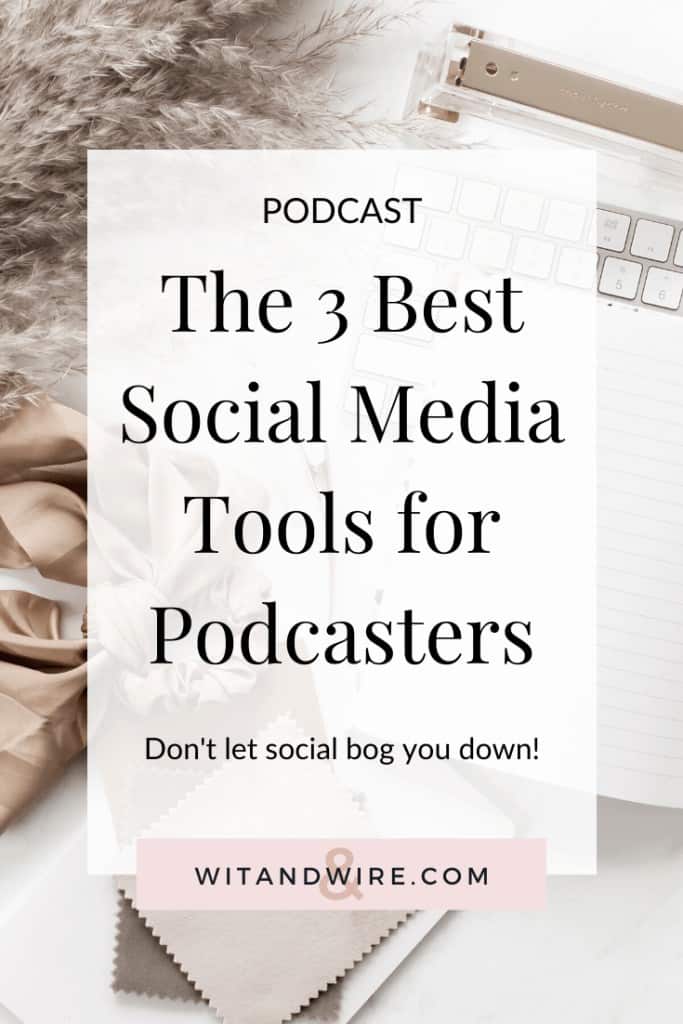You’ve got a great podcast, but how do you promote it? Social media can be one of the best ways to capture new listeners and engage your current audience. Your platforms, content, and strategy are going to be different than other businesses or influencers, so be sure to think about your podcast marketing when considering social media tools.
As an experienced podcaster with both successes and failures in the marketing department, I’m here to share my favorite platforms, free software you can use to design graphics, tips on what to post, and 3 social media scheduling tools I recommend.
Pinterest is a strong (yet underrated) platform for podcast marketing. Pinterest has become popular for DIY projects and recipes, but there’s so much more to it in 2021.
Not only are there 200 million active monthly users, but people go on the platform to discover new content and brands daily. These users are in the right place to click on your podcast, and in fact, the data shows that the click-through rate on Pinterest is comparable to Google’s organic search.
Pinterest allows you to reach people that are in the mood to discover new things. In fact, 67% of Pinterest users say that they’ve discovered a new brand or product on the platform. Your podcast could be the next new thing!
My recommendation for Pinterest (and other social media platforms) is consistent posting. We’ve all seen those accounts that post regularly for a week, then leave their audience hanging for 2 months, then get another spurt of energy. Consistent posting will keep your audience engaged.
If you video record yourself while taping your podcast then you are able to use that content multiple times. Not only can you upload the podcast to your website and onto podcast directories, but you can also use the video content on Facebook and other platforms.
This allows you to utilize video in your podcast marketing. You can post the video to your Facebook, or even better, you can connect with your audience on Facebook Live. This gives your dedicated fans a chance to listen to the podcast as you’re recording it live — meaning they get to listen to the parts that you might edit out later. This is an extra perk for those who listen to your Facebook Live, thus giving people an incentive to watch.
If you haven’t gone on FB Live before, it’s easy! You can stream directly to the Facebook followers of your FB business page, group, or personal profile from your iPhone, Android, or laptop webcam. You can incorporate the audience into your Live by asking questions and responding to comments in real-time. This makes the experience interactive for your audience and makes your podcast even more personal.
Instagram is, of course, one of the most popular social media platforms out there. The platform is continually growing. Half the users peruse the platform daily and 35% say they check Instagram several times a day.
Because there are so many users and engagement, Instagram has become a great marketing platform for promoting your business or website. It’s also perfect to use for your podcast marketing.
Use Instagram stories to announce to your audience that you have a new podcast episode available. If you have at least 10,000 followers, you can send them straight to the audio file. Insert the link in your story and a CTA so that a “swipe up” will allow your audience to listen to your podcast.
What’s quite popular are podcasts that feature interviews with influential people and professionals from specific industries. Use Instagram to let your audience know about your feature interviews. Use pictures of the individuals in your posts to catch the eye of people who are interested.
You can also tag your podcast guests on Instagram. This gives your audience the option to follow your guest’s profile in order to get to know them better if they’d like.
Related: How to launch a podcast in 60 days (without feeling overwhelmed)
3 social media tools for podcast marketing
There are so many social media scheduling tools, how do you know which one to use? I’ve used them all and I’m going to share the three best!
1. Sprout Social
Sprout Social is exactly what you need in a scheduling tool. It makes it easy to plan and post content on several social networks. Instead of having to switch back and forth between different platforms, you can publish on several different platforms at once.
For example, you can post to Pinterest, Instagram, and Facebook at the same time. This is a major time saver! I can’t tell you what a relief it is to plan content weeks ahead of time and be able to post simultaneously. It streamlines your social media efforts (except live streaming, of course), which leaves you free to focus on other parts of your podcast.
2. CoSchedule
All the scheduling tools claim to save you time. That’s the whole point. CoSchedule really delivers on this because it integrates with WordPress, so you can schedule blogs to WordPress and post content on social media at the same time.
CoSchedule also offers a comprehensive “Top Content Report”, a breakdown of engagement and social shares. This is AMAZING because it lets you see, with real data (as opposed to simply feeling like a post is doing well), what content is resonating most with your audience.
CoSchedule gives a special emphasis on content. You can track social performance, which is important, but the tool also gives you the opportunity to recycle and reuse the best performing posts automatically. The “ReQueue” feature refills your social media feed and capitalizes on your popular posts.
3. Tailwind
I’ve already talked about how awesome Pinterest is for gaining new listeners. But it can be a major time suck to post pins. What if there was a way that you could schedule your Pins just like you schedule other social media posts?
Enter Tailwind, the best Pinterest scheduler out there. It’s actually approved by Pinterest and allows you to schedule your pins ahead of time. This will ensure your audience gets regular Pins and that you don’t have to spend all day everyday posting.
Get your first month of Tailwind here using my partner link: Free Month of Tailwind
What should you post?
Now that you know what platforms and social media tools to use, the next logical question is: what should you post? Once you have a podcast, you need to promote it on your social media channels.
Podcast marketing is slightly different than promoting a blog or a consumer product. You need to speak to your audience.
I suggest creating images of the catchiest quotes from the episode and related graphics that are optimized for each platform (e.g. square for Instagram, vertical for Pinterest). For Facebook posts, you can also plan direct links to your website or Apple Podcasts. If there’s video, be sure to use that as well! The more content you have, the better you can promote your podcast.
Images
Images are an important part of your social media content. Don’t pick one stock image and think you’re set for all your podcast marketing needs. I like to create at a minimum, a normal thumbnail for the podcast (cover art is important!), a horizontal image for each episode, and a vertical image for Pinterest.
When you create an image for Pinterest, it helps to start by researching keywords related to your podcast topic. What images grab your attention? What other images are doing well on Pinterest, and what would you be likely to click on? Keep in mind that people tend to be drawn toward “happier” images and that Pinterest users are more likely to pin images without a human face.
Since Pinterest is a visual medium, think about what kind of images you can use to capture interest so that people will click on your Pin.
Bonus: Use Canva to design your social media graphics
So you know you need images, but how to make them? Canva is a free tool that is one of my top social media tools! It is so easy to create fun, beautiful, professional-looking images using this software. Instead of spending all day on Photoshop or Illustrator, Canva makes it effortless for those of us without design degrees to create beautiful images.
Save to Pinterest:


Melissa Guller is the founder of Wit & Wire, where we help everyday experts become profitable course creators. She previously worked full-time for Ramit Sethi, Teachable, and General Assembly. Today, she shares simplified tech tutorials and modern marketing strategies through our blog, YouTube, and Wit & Wire Weekly newsletter
